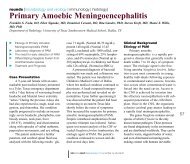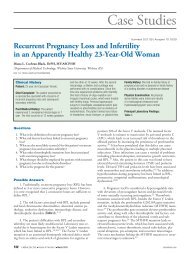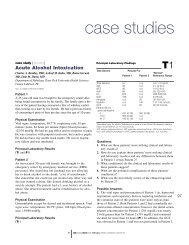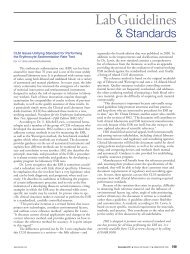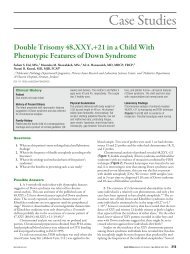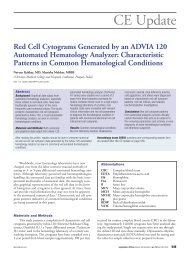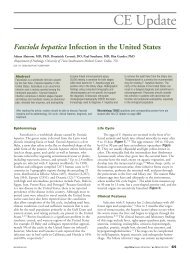Laboratory Variables That May Affect Test Results in Prothrombin ...
Laboratory Variables That May Affect Test Results in Prothrombin ...
Laboratory Variables That May Affect Test Results in Prothrombin ...
You also want an ePaper? Increase the reach of your titles
YUMPU automatically turns print PDFs into web optimized ePapers that Google loves.
seconds. These results may drastically<br />
affect the <strong>in</strong>terpretation of the PT assay<br />
and the warfar<strong>in</strong> dosage <strong>in</strong> the <strong>in</strong>dividual<br />
patients. 3<br />
The WHO <strong>in</strong> 1977 <strong>in</strong>troduced a standardized<br />
thromboplast<strong>in</strong> that was touted<br />
as an <strong>in</strong>ternational reference preparation<br />
(IRP). The hope was that each laboratory<br />
could develop a reference range for PT<br />
test<strong>in</strong>g that was to be compared to the<br />
IRP range. Tak<strong>in</strong>g this <strong>in</strong>itial step further<br />
the WHO <strong>in</strong> 1983 then put forth the idea<br />
for PT standardization based on a mathematical<br />
formula (INR) that uses the elements<br />
of the PT assay.<br />
The INR then would be the PT result<br />
that a laboratory would obta<strong>in</strong> if the test<br />
were performed us<strong>in</strong>g the standardized<br />
WHO reference thromboplast<strong>in</strong> reagent<br />
with an assigned ISI value of 1.0. Each<br />
assigned thromboplast<strong>in</strong> ISI could then<br />
compare the <strong>in</strong>dividual reagent sensitivity<br />
to an IRP that has been calibrated with a<br />
WHO reference plasma. The INR is calculated<br />
us<strong>in</strong>g the follow<strong>in</strong>g formula 3 :<br />
INR = (patient PT) ISI<br />
Mean normal PT<br />
Each <strong>in</strong>dividual laboratory would<br />
supply the mean normal PT. The INR<br />
method would then allow the physician to<br />
compare the PT results with different laboratories<br />
reagent/<strong>in</strong>strument<br />
comb<strong>in</strong>ations. Manufacturers now produce<br />
a wide variety of thromboplast<strong>in</strong><br />
with ISI values rang<strong>in</strong>g from 0.9 to 3.0.<br />
This wide range of ISI will produce a<br />
huge difference of PT results. 3 The INR<br />
was designed to correct for this<br />
difference. Therefore, if a patient were<br />
travel<strong>in</strong>g from one city to another the<br />
physician would have the advantage of<br />
expect<strong>in</strong>g a standardized INR value to<br />
ma<strong>in</strong>ta<strong>in</strong> a patient’s OAT range.<br />
As observed <strong>in</strong> the case report improper<br />
assignment of ISI values with different<br />
reagent/<strong>in</strong>strument comb<strong>in</strong>ations<br />
can result <strong>in</strong> cl<strong>in</strong>ically significant <strong>in</strong>accurate<br />
values. This difference <strong>in</strong> ISI values<br />
resulted <strong>in</strong> improper management of a<br />
large group of patients on OAT with catastrophic<br />
consequences. Huge<br />
differences <strong>in</strong> INR values have been reported<br />
when there are significant differences<br />
between low versus high ISI<br />
sensitivities <strong>in</strong> thromboplast<strong>in</strong>s. 4,5<br />
Preanalytic <strong>Variables</strong> of INR<br />
<strong>Test</strong><strong>in</strong>g<br />
Citrate Concentration<br />
Prothromb<strong>in</strong> time assays are<br />
performed on citrated platelet-poor<br />
plasma. The concentration of the sodium<br />
citrate anticoagulant can affect the PT time<br />
thus affect<strong>in</strong>g the INR value. 6-8 In the<br />
United States, until recently,<br />
approximately 80% of the PT assays were<br />
performed <strong>in</strong> plasma that was collected<br />
us<strong>in</strong>g vacuta<strong>in</strong>er tubes that conta<strong>in</strong>ed 3.8%<br />
(129 mol/L) sodium citrate. In 1998,<br />
NCCLS Subcomittee on Coagulation<br />
started to recommend that a 3.2% (109<br />
mol/L) sodium citrate concentration be<br />
used for most coagulation studies. This<br />
concentration was selected because the<br />
WHO was calibrat<strong>in</strong>g thromboplast<strong>in</strong>s<br />
us<strong>in</strong>g the 3.2% concentration. 9 Other <strong>in</strong>ternational<br />
standardization organizations also<br />
recommend us<strong>in</strong>g the 3.2% citrated anticoagulant.<br />
The osmolality of the 3.2% concentration<br />
is apparently closer to plasma.<br />
Higher INR values have been found <strong>in</strong><br />
some thromboplast<strong>in</strong> reagents <strong>in</strong> plasma<br />
collected with 3.8% citrated vacuta<strong>in</strong>er<br />
tubes. In one direct comparison study between<br />
the 2 citrate concentrations us<strong>in</strong>g a<br />
low ISI thromboplast<strong>in</strong>, the INR difference<br />
<strong>in</strong> 18.0% of the specimens showed a INR<br />
difference of 0.7. In another study, the difference<br />
on all specimens gave an average<br />
difference of 19.0%. The lower the ISI<br />
value is the more difference the citrate<br />
concentration makes <strong>in</strong> the INR results. 9 In<br />
platelet studies and test<strong>in</strong>g of blood bank<br />
products such as cryoprecipitate, the 3.8%<br />
citrate concentration is still recommended.<br />
Specimen Handl<strong>in</strong>g<br />
Improper specimen collection can<br />
also drastically affect the PT assay thus<br />
affect<strong>in</strong>g the INR value. This area has<br />
become controversial due to a number of<br />
studies that discuss the length of time<br />
and how a specimen can be stored be<br />
perform<strong>in</strong>g a PT assay. One study<br />
showed that storage of specimens for up<br />
to 6 hours at room temperature did not<br />
affect the PT results. 10 In another study,<br />
it was found that specimens from patients<br />
who were on low dose warfar<strong>in</strong> could be<br />
shipped overnight at room temperature<br />
©<br />
laboratorymedic<strong>in</strong>e> february 2003> number 2> volume 34<br />
without significantly chang<strong>in</strong>g the INR<br />
values. 11 Another study looked at specimens<br />
stored as whole blood. It found<br />
that after 3 days stored at room temperature<br />
that there was no significant change<br />
<strong>in</strong> the INR. 12 NCCLS guidel<strong>in</strong>es from<br />
1998 stated that uncentrifuged<br />
specimens for the PT/INR test or centrifuged<br />
plasma left of top of the separated<br />
cells stored at various temperatures<br />
from 2 to 24°C should be run with<strong>in</strong> 24<br />
hours from the time the sample was obta<strong>in</strong>ed<br />
from the test subject. 13 The PT<br />
results may vary from the time of collection<br />
of the specimen and storage of the<br />
sample if the subject was receiv<strong>in</strong>g hepar<strong>in</strong><br />
and was on OAT. The laboratory<br />
must be sure that the thromboplast<strong>in</strong> has<br />
a hepar<strong>in</strong> neutralizer to counteract the<br />
effects of hepar<strong>in</strong>. Evidence has also<br />
been presented that if specimens are<br />
stored at approximately 4°C that the<br />
PT/INR results may be shortened due to<br />
cold activation of FVII. 9 Our recommendation<br />
is that all specimens should be<br />
treated as if they were the last specimens<br />
that could be obta<strong>in</strong>ed from the test subject<br />
without hav<strong>in</strong>g to recollect the sample.<br />
If another assay is required, such as<br />
an APTT or factor assay, the prolonged<br />
storage times of >4 hours would possibly<br />
render the specimen compromised<br />
and required the patient to have a second<br />
venipuncture. This <strong>in</strong>creases time and<br />
expense for all concerned.<br />
More recently it has been discovered<br />
that the coagulation tube has been<br />
found to be a cl<strong>in</strong>ically significant<br />
source of variability <strong>in</strong> coagulation test<strong>in</strong>g.<br />
There has been controversy <strong>in</strong> us<strong>in</strong>g<br />
“partial-draw tubes” which required less<br />
vacuum to manufacture which resulted<br />
<strong>in</strong> 1.8 mL or 2.7 mL blood draws versus<br />
the conventional 4.5 mL draw with the<br />
blood to anticoagulant ratio of 9:1. S<strong>in</strong>ce<br />
the partial-draw tubes filled more slowly<br />
than the so-called full-draw tubes to<br />
platelets may have been activated due to<br />
lengthy exposure to shear forces aris<strong>in</strong>g<br />
from exposure to shear forces aris<strong>in</strong>g<br />
from draw<strong>in</strong>g blood <strong>in</strong>to the <strong>in</strong>creased<br />
headspace. The activated platelets then<br />
may release platelet-factor 4 or phospholipids<br />
which could compromise coagulation<br />
test<strong>in</strong>g. 14<br />
125




